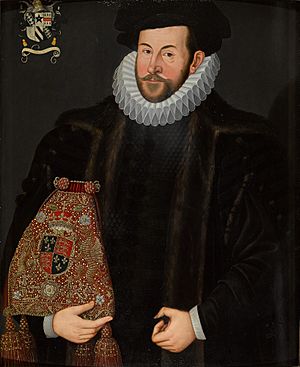John Puckering facts for kids
Sir John Puckering (born 1544, died 1596) was an important English lawyer and politician. He held big jobs like Speaker of the House of Commons and Lord Keeper of the Great Seal for Queen Elizabeth I. He served the Queen from 1592 until he passed away.
Contents
Sir John Puckering's Early Life
John Puckering was born in 1544 in a place called Flamborough, in East Riding of Yorkshire, England. He was the oldest son of William Puckering. His mother was Anne Ashton, whose family came from Lancashire.
Becoming a Lawyer
John Puckering started studying law at Lincoln's Inn in London in 1559. This was like going to law school. He finished his studies and became a lawyer, or "called to the bar," in 1567. After working for several years, he became a governor at Lincoln's Inn in 1575. In 1577, he was chosen as a "reader," which meant he taught law. By 1580, he became a "sergeant-at-law," a very senior type of lawyer.
Working in Parliament
Puckering became a Member of Parliament in 1581. This meant he was elected to help make laws for the country.
Speaker of the House
In 1585, Parliament met, and Puckering was chosen to be the Speaker of the House of Commons. The Speaker is like the referee or leader of the Parliament meetings. He made sure everyone followed the rules and kept discussions fair.
During one meeting, a bill (a proposed law) about Jesuits (a religious group) was being discussed. A member named Dr. William Parry used strong words about the bill. Puckering quickly told him to stop and had him taken away for a short time. After some talk, Parry said sorry and came back.
Because Puckering was so good at solving problems and giving speeches, he was chosen as Speaker again in 1586. This Parliament was very important because it decided what would happen to Mary, Queen of Scots. Puckering played a big part in these important decisions.
Protecting Parliament's Rules
In 1587, after Mary, Queen of Scots, was executed, another Member of Parliament named Peter Wentworth asked Puckering some questions about the rights of the House of Commons. Puckering didn't answer directly. Instead, he told a member of the Privy Council (the Queen's advisors) about the questions. Wentworth and four other members were then put in the Tower of London for a while.
The next year, Puckering was made a "Knight Bachelor," which meant he was given the title "Sir." He also became a "Queen's Sergeant," a special lawyer who worked for the Queen.
Queen's Sergeant Duties
As the Queen's Sergeant, Puckering worked on several important legal cases for the Queen. He was the lead lawyer for the Queen in the trial of Philip, Earl of Arundel. He also helped in the trial of John Udall. His last big trial was for Sir John Perrot, who was the lord deputy of Ireland.
In 1592, Puckering was given an even higher job: he was made the Lord Keeper of the Great Seal.
Lord Keeper of the Great Seal
Puckering was the Lord Keeper for four years. This was a very important role, like being the chief judge and a key advisor to the Queen. He was in charge of the Great Seal of England, which was used to make official documents legal.
During this time, he lived in large houses in London, first Russell House and then York House. He also had a country house in Kew. Queen Elizabeth I even visited him there in 1595!
Some of Puckering's official papers from his time as Sergeant and Lord Keeper were later published. These papers show his work, like questioning people who were Catholic recusants (people who refused to attend Church of England services).
Family Life
Sir John Puckering married Jane Chowne. Together, they had several children. Their son, Sir Thomas Puckering, 1st Baronet, became a baronet (a special title) in 1612. Thomas married Elizabeth Morley but did not have any children. His monument (a special memorial) can still be seen in St. Mary's Church in Warwick.
One of John's daughters, Catherine, married Adam Newton. Adam Newton was a tutor to Prince Henry, who was the son of King James I.
After Sir John Puckering died, his wife Jane married William Combe. William Combe and his nephew later sold some land to the famous writer William Shakespeare in 1602. Jane Puckering was buried in St. Mary's Church in Warwick in 1611.
Death and Burial
Sir John Puckering passed away on April 30, 1596, at his home. He was buried in Westminster Abbey, a very famous church in London where many important people are laid to rest. His grand monument (a large memorial) can still be seen there today.
|



